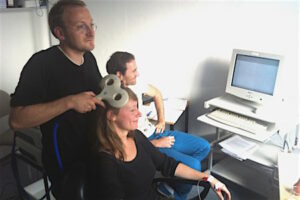When reading this title some people who work in the pain field might think: why anaesthetize the forearm when the hand is in pain? Actually, this “first step approach” was not intended to interrupt pain chronicity but to increase knowledge in basic pain physiology.
Sometimes, the overall aim to alleviate pain can put us under pressure and can hamper the basic understanding of the physiology underlying the development of chronic pain. This German-New Zealand team, with funding success from the research foundations of both countries (thank you!), was interested in the neurophysiological basics of neuropathic pain.
We know that intracortical inhibition is decreased in CRPS but we are not sure of the origins of the altered inhibition. There has been evidence of decreased levels of thalamic transmitters (for that you might take a look to some of the work of Luke Henderson, e.g. [1]). A decrease in inhibition might drive the maladaptive cortical processes that occur in those patients with chronic neuropathic pain.[2]
These cortical changes are associated with several changes in somatosensory (e.g. two point discrimination [3]) and motor function (loss of preciseness and velocity of movements [4]). Winston Byblow and Cathy Stinear’s group in Auckland showed that improvement in spatial tactile discrimination of the finger after forearm anaesthesia is related to an increase of cortical inhibition in healthy volunteers (as measured with transcranial magnetic stimulation (TMS) in a double pulse design) [5]. So we thought why not try to investigate whether forearm anaesthesia can help to reverse the neurophysiologic and behavioural changes in patients with chronic CRPS?[6] Interestingly enough, we were not only able to improve spatial tactile performance in these patients, in association to driving cortical inhibition values to the more normal range, but we were also able to improve motor function (pinch grip performance). This was shown in a double blinded placebo controlled design (anaesthetic cream against a placebo cream).

The next step will be to take a look at the changes in cortical representation of somatosensory fields of the affected fingers; do these pathologically decreased representation fields increase again after intervention? We already measured this, using high resolution fMRI in the same study design, but development of appropriate sensitive imaging techniques [7] took some time to be ready to evaluate these data. We will keep you posted on these findings. Another interesting issue might be to combine forearm anaesthesia with motor or somatosensory training protocols. This might enhance beneficial behavioural and cortical processes of training. Currently, we are trying to get funding for this next step.
About Martin Lotze
 Martin is a neurologist working in Greifswald/Germany on adaptive and maladaptive plasticity using functional imaging and transcranial magnetic stimulation. He is also one of our collaborators on BiM.
Martin is a neurologist working in Greifswald/Germany on adaptive and maladaptive plasticity using functional imaging and transcranial magnetic stimulation. He is also one of our collaborators on BiM.
About Winston Byblow
 Winston Byblow is Director of the Movement Neuroscience Laboratory. His research team examines the neural control of movement in health and disease, including ways to enhance motor recovery after stroke, and improve movement abilities of people with movement disorders.
Winston Byblow is Director of the Movement Neuroscience Laboratory. His research team examines the neural control of movement in health and disease, including ways to enhance motor recovery after stroke, and improve movement abilities of people with movement disorders.
References
[1] Henderson LA. Peck CC, Petersen ET., Rae CD., Youssef AM, Reeves JM., Wilcox SL., Akhter R, Murray GM., Gustin SM. (2013) Chronic Pain: Lost Inhibition? The Journal of Neuroscience, 33(17):7574 –7582.
[2] Di Pietro, F., McAuley, J.H., Parkitny, L., Lotze, M., Wand, B.M., Moseley, G.L., and Stanton, T.R. (2013). Primary somatosensory cortex function in Complex Regional Pain Syndrome: a systematic review and meta-analysis. The Journal of Pain 14, 1001-1018.
[3] Pleger, B., Ragert, P., Schwenkreis, P., Forster, A.-F., Wilimzig, C., Dinse, H., Nicolas, V., Maier, C., and Tegenthoff, M. (2006). Patterns of cortical reorganization parallel impaired tactile discrimination and pain intensity in complex regional pain syndrome. Neuroimage 32, 503-510.
[4] Maihofner C, Baron R, DeCol R, Binder A, Birklein F, Deuschl G, Handwerker HO, Schattschneider J. The motor system shows adaptive changes in complex regional pain syndrome. Brain 2007; 130:2671-87.
[5] Petoe MA, Molina Jaque FA, Byblow WD, Stinear CM. (2013). Cutaneous anesthesia of the forearm enhances sensorimotor function of the hand. Neurophysiology; 109:1091-6.
[6] Strauss S, Grothe M, Usichenko T, Neumann N, Byblow WD, Lotze M. (2015). Inhibition of the primary sensorimotor cortex by topical anesthesia of the forearm in patients with complex regional pain syndrome. Pain. 2015 Dec;156(12):2556-61. doi: 10.1097/j.pain.0000000000000324.
[7] Pfannmöller J.P., Schweitzer, R., Lotze M. (2015) An Automated Analysis Protocol for high resolution BOLD-fMRI Mapping of the Fingertip Somatotopy in Brodmann Area 3b. Magnetic Resonance Imaging, in press.



